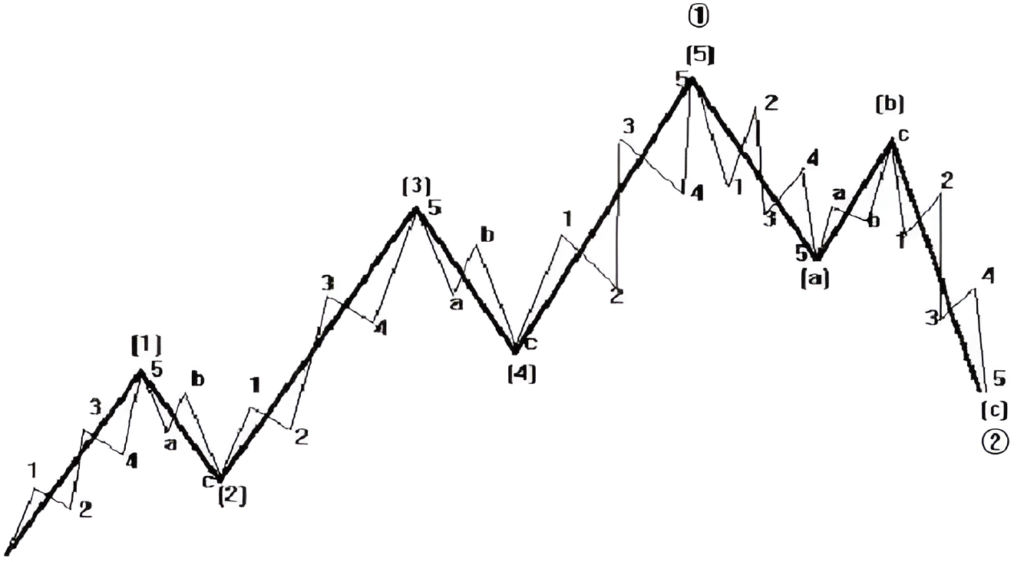The 8-Wave Rule is a fundamental idea in Elliott Wave Theory, a trading strategy that centers on organized wave patterns in price changes. This finding lends credence to the idea that waves move in sets, with the longest waves typically covering more ground. Trading with the trend, identifying Wave 1, comprehending corrections, spotting diagonal patterns, following extended waves, avoiding traps, tracking the market, and clearly labeling wave counts are all part of Wave Guidelines.
Riding the market’s waves is all about timing, and Elliott Wave Theory provides a roadmap for navigating trends like a professional. What’s the goal? Whether it’s the first wave of a strong third wave, a fifth wave surge, or even during a corrective period, the goal is to join the next rally after a correction ends.
But here is the catch: You are responsible for knowing when to enter and depart safely. That’s where Elliott Wave rules and guidelines come in, assisting you to maximize earnings and reduce risk while trading any asset.
Elliott Wave Rules Chart
| Rules of Elliott Wave | |
|---|---|
| Rule 1 | Wave 3 cannot be the smallest impulse wave. |
| Rule 2 | Wave 2 cannot extend beyond Wave 1's starting point. |
| Rule 3 | Wave 4 cannot overlap with Wave 1's price range. |
| Rule 4 | Extended waves are likely to be longer, with Wave 3 being the strongest. |
| Rule 5 | Two of the three impulse waves are likely to be the same in length. |
What Are the 3 Rules of Elliott Wave?
Rule 1: Wave 3 Can’t Be the Shortest Impulse Wave
In a five-wave impulse sequence (Waves 1, 3, and 5), Wave 3 must always be longer than one of the other two motive waves. Wave 3 is usually the strongest and fastest-moving wave; thus, it should never be the smallest. If it is the smallest, the wave count is incorrect.
Rule 2: Wave 2 Can’t Go Beyond Where Wave 1 Started
Wave 2 is a corrective wave, which means it reverses the trend established by Wave 1. However, it should never retrace more than 100% of Wave 1’s length; otherwise, the pattern is incorrect.
Rule 3: Wave 4 Can’t Go Into the Price Range of Wave 1
Wave 4 is another corrective wave; however, it should not overlap with Wave 1’s price range in a normal impulsive pattern. (Exception in Leading Diagonal.) If Wave 4 enters the Wave 1 area, the structure violates the Elliott Wave criteria.

What Are the Rules of Wave Theory?
Correction After 5 Wave Sequence
Once a 5-wave sequence is complete, the market moves in a predictable manner. What’s the main rule? Anticipate a correction that is greater than any of the previous two corrections inside the motive waves. This signal indicates that after the final fifth wave, the retracement (Wave 2 or Wave 4) will not be a little dip but rather a big decline, typically creating an A-B-C correction. This rule enables traders to prepare for trend changes, avoid chasing the peak, and recognize probable reversal zones before the next major move starts.
Spotting the End of a Correction
Corrections in Elliott Wave Theory usually occur in a three-wave pattern (A-B-C), but here’s the essential insight: The last wave (Wave C) consists of five smaller waves. This sign indicates that if you see a fifth wave appearing inside Wave C, the correction is probably reaching its end. Traders and investors use this technique to anticipate probable reversals, timing their entry intelligently, and plan for the next impulsive move.
Spotting the Extended Wave
According to Elliott Wave Theory, one of the three impulse waves (Wave 1, Wave 3, or Wave 5) in a five-wave sequence is likely to be extended, which means it will be much longer and stronger than the others. In most situations, Wave 3 is the strongest, since it often coincides with considerable market momentum. Identifying an extended wave early on may help traders ride the greatest price movements, maximize profits, and prevent premature exits.
Equality Rule in Elliott Wave Theory
According to Elliott Wave Theory, two of the three impulse waves (1, 3, and 5) have a high probability of being the same in length—typically about 100% of each other. If Wave 3 extends, it is quite likely that Wave 5 will equal Wave 1 in distance. This rule enables traders to anticipate price goals, assess prospective wave lengths, and make educated entry and exit decisions.
What Is the 8 Wave Rule?
Price changes in Elliott Wave Theory follow organized wave patterns rather than occurring at random. While the conventional Elliott Wave sequence is made up of five impulse waves and three corrective waves, traders often encounter a phenomenon known as the 8-Wave Rule.
The idea is based on the fact that waves travel in sets, with the eighth wave—typically the largest and strongest—often extending farther than the others, similar to a powerful wave reaching further up the beach. In market terminology, this phenomenon generally correlates to an extended wave within the larger Elliott Wave structure, which is often observed in Wave 3 of an impulse or Wave C of a correction.
Recognizing this concept may assist traders as well as investors in discovering high-momentum price movements and possible breakout moments. Identifying the dominant wave inside a structure may help you ride the greatest move while limiting risk, which is a crucial edge in any asset market!
Elliott Wave Guidelines
Trade with the Trend, Not Against It
One of the most frequent pitfalls in Elliott Wave Theory is attempting to trade against the wider trend during a period of contraction. Instead of following short-term movements, focus on determining where the correction is likely to stop and positioning yourself to ride the next impulse wave in the direction of the major trend. This method reduces needless risks and increases your risk-reward ratio.
The Challenge of Identifying Wave 1
Wave 1 in Elliott Wave Theory is not often a simple, visible formation. When the market goes down sharply, it often builds a base and tests the lows several times before it really turns around. This motion may sometimes result in a wedge-pattern structure known as a diagonal triangle. In a bull market, the sequence may be reversed. Since recognizing Wave 1 early may be difficult, traders often employ oscillators and divergence studies to confirm the setup.
Don’t Force the Wave Count
When there is no specific wave count, you must stay out of the market. Forcing a pattern that is not there might result in incorrect judgments and needless risks. It is okay to use provisional labels, but always approach wave counting with an open mind—markets do not move perfectly, and uncertainty is an important part of the game. If the structure is unclear, it is advisable to step back, wait for confirmation, and trade only when the waves align with a favorable setup.
Understand the Corrections
A typical situation is two five-wave cycles joined by a three-wave action, which may rectify a prior five-wave sequence to the same or greater degree. This guide assists traders in recognizing whether a correction is still in progress and avoiding premature entry. Understanding these larger-degree corrective structures allows you to enhance your timing and trade any asset with confidence!
Diagonal Pattern Signals Wave 3 Extension
In Elliott Wave Theory, when Wave 1 develops a diagonal pattern, it usually indicates that Wave 3 will be extended. A diagonal in Wave 1 often indicates a weaker first push, suggesting that the market is building momentum for a stronger, more aggressive Wave 3. This rule helps traders predict high-probability setups, since an extended Wave 3 might result in dramatic price movements.
Aftermath of an Extended Fifth Wave
When an extended Wave 5, especially in a diagonal pattern, completes its move, the resulting correction is often sharp and stunning. When the market reaches its end, the exhaustion of purchasing or selling pressure triggers a swift reversal. Understanding this guideline is critical for controlling risk and making successful choices.
The Power of a Failed Fifth Wave
A failing fifth wave is a crucial guide in Elliott Wave Theory, signaling that the following move in the opposite direction will be significant. Many traders either fail to detect the failure early on or believe it is only a modest Wave 1 of a prolonged fifth wave. However, detecting a failed fifth in time enables you to plan for a swift reversal and position yourself for the next major play. Understanding this guideline might help you avoid traps and profit from momentum changes.
Follow the Market, Not Your Emotions
Allowing personal feelings to take priority over market sentiment is one of the most common blunders made by traders. Elliott Wave Theory encourages you to look at the large picture and use shorter-term charts to refine entry points for medium-term trades. The key to success is to understand why you’re taking on a position rather than just following your gut feelings. Furthermore, always clearly label your wave counts one degree lower than your trading time frame to improve accuracy in recognizing trend changes and high-probability setups in any asset!
How to Use Elliott’s Rules And Guidelines to Label Charts Correctly?
Think about Elliott Wave Theory as a road map for understanding how markets move according to natural laws and repeated price patterns. The same wave ideas apply whether examining stocks, forex, cryptocurrency, or any other market. But here’s the catch: you can’t simply count waves randomly! Keep in mind the rules, personality, and features of each wave to ensure your wave count is consistent with market structure and price movement. By mastering this ability, you will be able to properly identify trends, prevent miscounts, and confidently traverse charts like an expert!
Final Thoughts
Elliott Wave Analysis, while a powerful tool, does not guarantee wealth. Consider it a blueprint rather than a GPS; although it provides guidance, the journey still needs skills, patience, and adaptability. Markets are unpredictable, and errors can happen, but if you remain disciplined and look for high-probability settings, the chances are in your favor. The goal is to maintain a mix of confidence and prudence, constantly managing risk properly. Be patient, trust the process, and allow the waves to lead you to better trading selections!













Leave a Reply